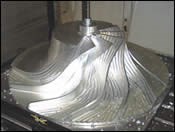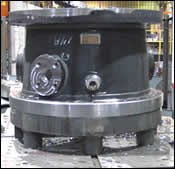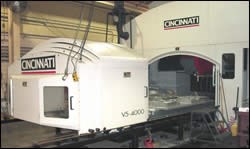Fit The Strategy, Not The Job
This shop faced two big challenges—keeping an important job from going overseas and positioning itself for future growth. Simultaneous five-axis machining helped the shop meet both challenges simultaneously.
Share







Takumi USA
Featured Content
View More

ECi Software Solutions, Inc.
Featured Content
View More
.png;maxWidth=45)
DMG MORI - Cincinnati
Featured Content
View More
Hwacheon Machinery America, Inc.
Featured Content
View MoreIn 1997, D & G Machine Products was at a crossroads. For some time, the company had been producing a critical part for one of its best customers. Now this customer was expecting a surge in orders for this part. Plus, the customer wanted a 5 percent cost reduction. “We may have to take this part overseas,” was the ominous suggestion.
At first, D & G added more machines like the ones it was using at the time. It helped double output and achieved the required cost reduction simply on the basis of economy of scale. Lead times were still about the same.
The company knew that its process for making this part would have to be revamped. However, it took a look at the larger picture and saw an opportunity to further its broader strategic goals. The company had other customers in other industries, with similar workpieces that would benefit from more capabilities. Not only that, new jobs from new customers could be pulled in.
D & G gained a new perspective on what to do about the threatened part. For one thing, capital equipment purchases would have to fit the larger strategy, not just this part. For another, new machines would have to be automated and flexible to minimize operator involvement. Quality would have to improve and be ascertainable. New machines would have to leverage the capabilities of existing equipment.
Taking this approach was wise. D & G kept the part from going overseas. Over a 5-year period, the shop reduced costs a total of 30 percent. It cut lead times by 40 percent. Best of all, as this job is tapering off, the company is bringing in more profitable jobs that go across the same machines, enhancing the machines’ earning power.
The centerpieces of this strategy are machining centers with full five-axis capability. Although simultaneous five-axis cutting isn’t needed for the parts that almost got away, it fit the larger strategy that D & G was after.
A Strategy Emerges
Like many metalworking companies, D & G started out as a garage shop. That was in 1967. In the first 5 years, the company added fabrication and welding to complement its growing machining services. D & G moved to larger and larger facilities several times before taking up its current location in Westbrook, Maine, very near Portland.
For the last decade or so, D & G has been providing large components for power generation, aerospace, semi-conductor assembly and pulp and paper equipment. It has about 110 employees.
The part that brought D & G to a turning point in 1997 was typical of the jobs the shop was best known for. Roughly the size of bass drum, the part is a closely toleranced component for a family of land-based gas turbine products. Each finished piece basically consists of a hollow cylinder to which heavy flanges are welded, one at each end. A number of precisely located holes are drilled along its circumference at an angle. More holes and contoured pockets are machined on the faces of the end flanges. In 1996, the company had produced slightly more than 300 of these parts.
At the time, this part involved about 100 separate operations in 10 setups. Lead times ran between 20 and 26 weeks. By adding a four-axis machining center and a palletized VTL, D & G was able to produce more than 800 of these parts in 1997. With orders expected to double again the following year, D & G recognized that it couldn’t continue in this direction.
It was clear that the number of manufacturing steps and the number of setups would have to be cut in half. The shop determined that a CNC lathe with live tooling could eliminate secondary milling operations and increase throughput on turning operations by 30 percent. These operations could be performed in one setup. Parts leaving the turning center would be ready for welding.
After welding, the new plan called for all final machining to be performed in only two setups—one with the part laid on its side and one with the part standing on end. This could only be accomplished with a machine capable of five axis positioning. Rotating the part on an indexing table and swiveling the spindle head would give the cutting tool access to the workpiece from every required angle.
"As we developed the plan,” recalls Duane Gushee, D & G president, “we wanted to be sure any new machines could be used on other products within our different market sectors.” That’s when the step to five-axis simultaneous cutting became clear. “We envisioned cells where production runs of two or three different markets could run concurrently. This would minimize setup time and allow us to adjust production rates on the fly.” Mr. Gushee says.
Palletized Systems
D & G chose a five-axis machining center with multiple pallets. At the time, Cincinnati Machine (Cincinnati, Ohio) was introducing its Magnum 800 horizontal machining centers, and D & G ordered one of the first of these machines off the line. This 60-hp machine has a 57- by 72- by 61-inch work zone and is equipped with a seven-station pallet transfer system.
Two pallets, one for the laydown and one for the upright setups, were dedicated to the gas turbine part. These pallets, with qualified fixtures permanently mounted, are the only equipment devoted to this part, although all the cutting tools for this job are maintained in the tool changer at all times. With this machine in place, the shop produced 1,500 of the parts in 1998. Lead times were down to 16 weeks. In 1999, the company installed a second Magnum HMC from Cincinnati. This addition duplicated the seven-pallet configuration but had a slightly larger work envelope. A second turning center with live tooling complemented this new capacity. That year, D & G produced 2,300 of the gas turbine parts and reduced lead times to 12 weeks.
A revamped fabrication process (see sidebar) contributed to further lead time reductions and cost savings. In 2001, the shop produced 4,600 parts and had lead times down to only 8 weeks.
Enabling Technologies
All of the shop’s five-axis machines are equipped with probing systems. Plant manager Charlie Tarling identifies this feature as one of the keys to productivity. Pallets are loaded according to the shop’s scheduling priorities and are shuttled automatically to the machine in a sequence determined by the schedule.
The probe verifies that the correct workpiece is arriving on the incoming pallet and checks that the correct program has been downloaded to the machine controller. On certain workpieces, the probe also scans critical features to verify that adequate stock conditions exist to yield a good part. Any condition not met triggers an alarm and aborts the program. During the unattended second shift, a rejected pallet returns to its station in the shuttle system and the next scheduled pallet takes its place.
During the first shift, one machine operator monitors both five-axis machines. Most machining cycles are relatively long on these large parts, so the operator performs secondary operations and inspections of finished parts stored on the pallet system. For example, the operator installs couplings and wire inserts on the gas turbine part so that it can move directly to painting and shipping without delay.
Because the strategy behind these machining centers calls for several product lines to run concurrently, keeping track of each machine’s workload is essential. According to Phil Jordan, systems manager, approximately 150 jobs will be in queue at any time for the shop’s five-axis machining centers. D & G has been a long-time user of JobBoss shop software from JobBoss Software/Exact (Minneapolis, Minnesota). The shop has implemented real-time data collection throughout all of its manufacturing areas.
Real time data ensures that the shop schedule is current and frequently adjusted to avoid excessive bottlenecks. Effective scheduling, in turn, ensures that the five-axis machines are almost never idle and that work crossing these machines adheres to current priorities. The probing systems are linked to the data collection network, allowing probing results to be entered automatically into the shop database.
Partnering For More Five-Axis
Because D & G’s five-axis machining capability was planned to fit the strategy, not the job, the value of that approach is proving itself now that orders for the gas turbine product are tapering down. This transition began in 2002. The mix of work for aerospace and semiconductor industries has increased. One result is that the use of simultaneous five-axis cutting has gone up. This development helps maintain the profitability of this equipment in the face of an economic downturn while allowing the company to offer customers price reductions to keep them competitive in a global marketplace.
D & G has further leveraged its simultaneous five-axis machining capability by partnering with a leading company that specializes in five-axis machining of aerospace and turbomachinery impellers and blisks. The company, Turbocam of Dover, New Hampshire, is best known for its unique software services in support of prototyping and development in the area of complex bladed disks and similar geometries. It also handles full production runs of such workpieces, with a large number of five-axis machines in house. However, that capability is limited to workpieces under 30 inches in diameter.
As a partner, D & G provides Turbocam with five-axis machining for workpieces from 30 to 50 inches in diameter. According to Eric Tanguay, D & G sales manager, Turbocam is uniquely positioned to attract this kind of work because of its reputation in the field. “Turbocam provides us with the CNC program for five-axis machining of these impellers and blisks. That allows us to take advantage of their expertise in this area. Likewise, Turbocam benefits from our fast turnaround and machining capacity, allowing the company to offer its customers added services and greater responsiveness.”
No Standing Still
The latest thrust in D & G’s constant effort to stay ahead of the competitiveness curve in five-axis machining is the addition of the V5-4000 bridge-type vertical machining center from Cincinnati Machine. Delivered in the fall of 2002, it is the first of its kind to be installed anywhere. The machine is designed to handle simultaneous five-axis machining of large aluminum parts typically produced on multi-spindle gantry machines. It features a 24,000-rpm spindle and a 160- by 80-inch work zone.
"This machine gives us feed rates four times faster than the existing five-axis machines,” says Steve Sullivan, vice president of sales, “and it allows us to do high speed machining.” He also explains that the company is after workpieces that are too big to fit on the pallets of the older machines. “We need this capability to grow our aluminum work, where throughput on larger pieces determines competitiveness.”
Although this machine is useful for machining airframe components such as bulkheads, floor beams and wing spars from aluminum plate, it also suits the aluminum workpieces D & G produces for leading manufacturers of semiconductor assembly equipment. This versatility is keeping with the company’s policy to invest only in equipment that allows the shop to serve more than one of its core market segments.
Once again, the company has been careful to fit the strategy, not the job.
Related Content
Finding the Right Tools for a Turning Shop
Xcelicut is a startup shop that has grown thanks to the right machines, cutting tools, grants and other resources.
Read MoreBuilding Machines and Apprenticeships In-House: 5-Axis Live
Universal machines were the main draw of Grob’s 5-Axis Live — though the company’s apprenticeship and support proved equally impressive.
Read MoreSame Headcount, Double the Sales: Successful Job Shop Automation
Doubling sales requires more than just robots. Pro Products’ staff works in tandem with robots, performing inspection and other value-added activities.
Read MoreInside Machineosaurus: Unique Job Shop with Dinosaur-Named CNC Machines, Four-Day Workweek & High-Precision Machining
Take a tour of Machineosaurus, a Massachusetts machine shop where every CNC machine is named after a dinosaur!
Read MoreRead Next
Registration Now Open for the Precision Machining Technology Show (PMTS) 2025
The precision machining industry’s premier event returns to Cleveland, OH, April 1-3.
Read MoreBuilding Out a Foundation for Student Machinists
Autodesk and Haas have teamed up to produce an introductory course for students that covers the basics of CAD, CAM and CNC while providing them with a portfolio part.
Read More5 Rules of Thumb for Buying CNC Machine Tools
Use these tips to carefully plan your machine tool purchases and to avoid regretting your decision later.
Read More










.png;maxWidth=150)































.jpg;maxWidth=300;quality=90)


.jpg;maxWidth=300;quality=90)







